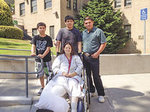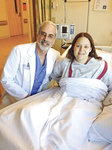

On the morning of Aug. 19, 34-year-old Jessica Rodriguez checked into Oregon Health & Science University (OHSU) to have a right leg below the knee amputation performed. It was a surgery she had been anticipating for several weeks, bringing her feelings of stress, doubt and also, hope.
“I went into the surgery feeling pretty confident that it would all turn out good,” Rodriguez said. “My family from all over the states came to provide us with comfort and support during this difficult process.”
Rodriguez, a Battle Ground resident, made the difficult decision to have her right leg amputated after suffering from a connective tissue disorder basically her entire life.
As she tells it, when she was about 7 years old, she started to notice that on the top portion of her right foot her skin was very different. She was able to pull on it and stretch it out like playdough, sort of like she was wearing nylons. At first, as a child, she thought her stretchy skin was pretty cool, but that quickly changed as the stretchy skin began changing and spreading around her entire right leg.
“I started to have a lot of weakness in that leg,” she said. “I wasn’t able to fully keep up with my peers growing up, my leg always hurt and felt so weak, I knew I was a little different than others.”
Over the years growing up, Rodriguez said her parents took her to several doctors and specialists, and she had countless tests done. As she got older, the skin on her right leg really began to change, becoming very thin, translucent and discolored, and the leg constantly ached.
At the age of 14, Rodriguez started to notice that the skin around her chest area was changing, turning red and bluish and becoming very discolored. The skin became thin, translucent and painful, just like the skin on her leg. Still, however, visit after visit to different doctors turned up no answers or explanations as to what was causing these problems.
At 18 years old, Rodriguez became pregnant with her first son, Carlos. She had a good pregnancy and everything went well through the delivery. However, not long after her pregnancy, she noticed her right leg swelling significantly and causing a great deal of daily pain. She soon became pregnant with her second son, Anthony, and enjoyed a good pregnancy with him as well.
As she entered her mid 20s, her right leg continued to get much worse. The leg would sometimes swell up so badly that the skin would tear open and leak lymph fluid, and Rodriguez would sometimes have to cut her jeans off to get undressed. At this point, it was almost impossible for her to wear a shoe on her right foot. Finally, after many visits back to the doctor’s office, Rodriguez was diagnosed with chronic lymphedema. Lymphedema is caused by a blockage in a person’s lymphatic system. The blockage prevents lymph fluid from draining well and, as the fluid builds up, the swelling continues.
There is no cure for lymphedema, but it can sometimes be managed.
Rodriguez continued to deal with the pain of her swelling leg for years. Eventually, it led her to having the amputation of toes three, four and five on her right foot about five years ago.
“It was a tough decision, but the pain that I was feeling was so bad and miserable that I knew I had to make the tough decision, better my toes than my leg, I would think,” she said.
After going through some complications after having her toes amputated, Rodriguez went to OHSU and they sent her to a vascular anomalies clinic, where she saw multiple providers at a time. After running numerous tests, she was told she also had a very extensive arteriovascular malformation, which is an abnormal collection of blood vessels. Rodriguez was referred to a specialist in Denver, CO, and traveled there several times to have back-to-back surgeries. To date, Rodriguez said she has had about 17 surgeries on her malformation.
Although she has been told she has lymphedema, Klippel-Trenaunay Syndrome, Ehlers Danlos Syndrome and a rare gene mutation, Rodriguez had tried to remain positive. Choosing to have her right leg amputated was a last resort, but she is hopeful that her pain will now go away, for the most part.
Rodriguez said the amputation surgery was long, as hospital staff took her to the operating room at 7:30 a.m. and finished around 5 p.m.
“I remember waking up and coming around slowly after surgery and wondering if my leg was gone,” she said. “I took a quick peek underneath my sheets and saw my leg was in a white cast, and then the nurse looked at me and said everything went as planned. I was in a tremendous amount of pain, it felt as if my entire leg was pushed into this small, yet huge cast. The only way to describe how it felt was like a huge charlie horse (cramp) that would not subside, a ton of pressure as if what was left underneath the cast weighed 100 pounds, along with intense tingling and burning.”
Three days after the amputation, Rodriguez insisted on using her walker to get up and use the restroom. She was amazed that she was able to walk, even though it was with help, three days after having her leg amputated.
“I truly amazed myself at this point and knew from this day forward my life was going to change, yet I know that it is just another leap I am going to have to take,” she said.
Rodriguez is now going through physical therapy and occupational therapy to help her regain strength and balance. Her leg was placed in a medical apparatus to shrink the limb, which she will need to wear daily with no removal, expect for cleanings, for six to eight months prior to being fitted for a prosthetic leg. Her goal now is to take it slow, wear the shrinking device and not rush anything.
After spending quite a bit of money on doctor’s visits, specialists, surgeries and other medical needs, Rodriguez and her family are in need of some donations for basic day-to-day expenses such as rent, food, school supplies for her sons, gas, etc. Anyone wishing to donate can read more updates on her story can visit http://www.gofundme.com/54j9eg.
“Six to eight months may seem like forever, but my diseases were a lifelong battle, so I know I can do it,” she said. “I will stay strong and keep a positive outlook on everything. I am so thankful for how kind people have been in helping me prepare for this lifelong change that I will be facing. With the support from my husband, parents, siblings, family, friends and the community I will stay strong, keep positive, follow through with all of my therapy and by next year I will be walking on two legs, with I hope no more pain.”